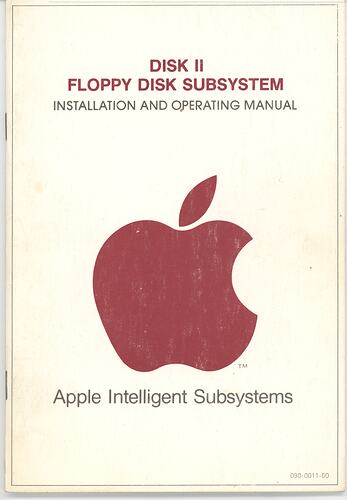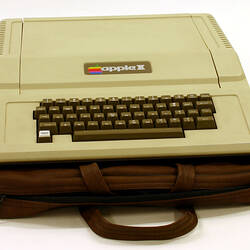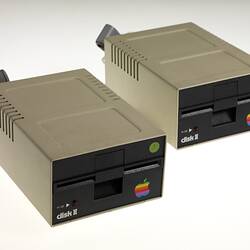When the Apple II was first released in 1977, the computer was run from programs and data imported from a standard cassette tape played on a standard cassette recorder.
A cable ran from the Audio Output jack on the cassette player (usually labelled External Speaker or Headphones) into the Cassette In jack on the back of the Apple II. A similar cable ran from the Cassette Out jack on the Apple II to the microphone jack of the cassette player. Tape data storage and retrieval was slow and did not permit random access to the data on the tape. The cassette tape data storage and retrieval system also relied on careful attention to tone and volume controls, a method that was less than satisfactory for Apple and its competitors, including Tandy Corporation with its TRS-80 and Commodore International with its Commodore PET 2001. At the time, floppy disks were being used to supplement reel-to-reel tape drives on mainframe computers. What was needed was the ability to program the Apple II through a floppy disk drive, and in December 1977, Apple's President Mike Markkula challenged Steve Wozniak to get the Apple II to control a floppy disk drive. Wozniak worked on a system that would control a disk drive made by Shugart in Silicon Valley and by the first week of January 1978 he had succeeded. He refined the system further and by the end of January it was finished. Sales of the disk drive began in July 1978. The drive was interfaced with the computer through a card that was plugged into one of the expansion slots on the computer motherboard - another Apple innovation. Alps Electric Company of Japan designed a clone of the Shugart drive for Apple at a significantly reduced cost, so that Apple was able to sell the disk drive cheaply and still make a huge profit. Wozniak's design of the disk controller was regarded as extremely elegant and a significant technological advance. His innovations allowed more data to be stored on the floppy disk, and for the data to be written to and retrieved from the disk more efficiently. At the time of its introduction, this technology was unique to Apple computers. According to Frank Rose, in his book West Of Eden the 'Disk II . suddenly transformed the Apple II from a gadget only hard-core hobbyists would want to something all sorts of people could use. Few outsiders realized it, but in strategic terms, Woz's invention of the disk controller was as important to the company as his invention of the computer itself'(p.62). This claim may be overrated. While the Apple II became the first personal computer as we know it today by propelling the transition from a home kit for electronic hobbyists to an object that could achieve outcomes for the masses, to suggest that Disk II's importance was comparable with that of the Apple II itself may be an exaggeration. Nevertheless, the cheapness of the Disk II drive, its reliability and effectiveness was an important factor in the increased sales of the Apple II that resulted in the creation of the personal computer market and Apple's temporary dominance of that market. What can be said is that more than any other machine, it moved the home computer from the worktable of the hobbyist to the family living room, and that whilst the Apple series debuted in 1977, it became a definitive home computer after the introduction of the Disk II drive in 1978. While the advantage that Apple gained with the Disk II was not long term, the contribution this innovation made to the emerging industry and to productive personal computing was considerable.References
Rose, Frank (1989). West Of Eden: The End Of Innocence At Apple Computer. New York: Penguin Books. Accessible at: http://apple2history.org/history/ah05.html#DiskII
Young, Jeffrey S (1988). Steve Jobs - The Journey Is The Reward. Lynx Books.
More Information
-
Keywords
-
Authors
-
Article types


